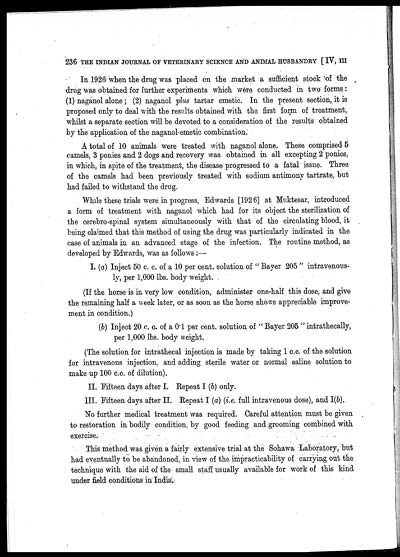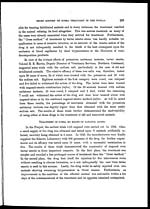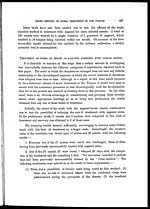Medicine - Veterinary > Veterinary colleges and laboratories > Indian journal of veterinary science and animal husbandry > Volume 4, 1934 > Original articles > Short history of surra treatment in the Punjab
(264) Page 236
Download files
Individual page:
Thumbnail gallery: Grid view | List view

236 THE INDIAN JOURNAL OF VETERINARY SCIENCE AND ANIMAL HUSBANDRY [ IV, III
In 1926 when the drug was placed on the market a sufficient stock of the
drug was obtained for further experiments which were conducted in two forms :
(1) naganol alone; (2) naganol plus tartar emetic. In the present section, it is
proposed only to deal with the results obtained with the first form of treatment,
whilst a separate section will be devoted to a consideration of the results obtained
by the application of the naganol-emetic combination.
A total of 10 animals were treated with naganol alone. These comprised 5
camels, 3 ponies and 2 dogs and recovery was obtained in all excepting 2 ponies,
in which, in spite of the treatment, the disease progressed to a fatal issue. Three
of the camels had been previously treated with sodium antimony tartrate, but
had failed to withstand the drug.
While these trials were in progress, Edwards [1926] at Muktesar, introduced
a form of treatment with naganol which had for its object the sterilization of
the cerebro-spinal system simultaneously with that of the circulating blood, it
being claimed that this method of using the drug was particularly indicated in the
case of animals in an advanced stage of the infection. The routine method, as
developed by Edwards, was as follows:—
I. (a) Inject 50 c. c. of a 10 per cent. solution of " Bayer 205 " intravenous-
ly, per 1,000 lbs. body weight.
(If the horse is in very low condition, administer one-half this dose, and give
the remaining half a week later, or as soon as the horse shows appreciable improve-
ment in condition.)
(b) Inject 20 c. c. of a 0.1 per cent. solution of " Bayer 205 " intrathecally,
per 1,000 lbs. body weight.
(The solution for intrathecal injection is made by taking 1 c.c. of the solution
for intravenous injection, and adding sterile water or normal saline solution to
make up 100 c.c. of dilution).
II. Fifteen days after I. Repeat I (b) only.
III. Fifteen days after II. Repeat I (a) (i.e. full intravenous dose), and I(b).
No further medical treatment was required. Careful attention must be given
to restoration in bodily condition, by good feeding and grooming combined with
exercise.
This method was given a fairly extensive trial at the Sohawa Laboratory, but
had eventually to be abandoned, in view of the impracticability of carrying out the
technique with the aid of the small staff usually available for work of this kind
under field conditions in India.
Set display mode to: Large image | Zoom image | Transcription
Images and transcriptions on this page, including medium image downloads, may be used under the Creative Commons Attribution 4.0 International Licence unless otherwise stated. ![]()
| Permanent URL | https://digital.nls.uk/75234508 |
|---|
| Description | Covers articles from 1934. |
|---|




